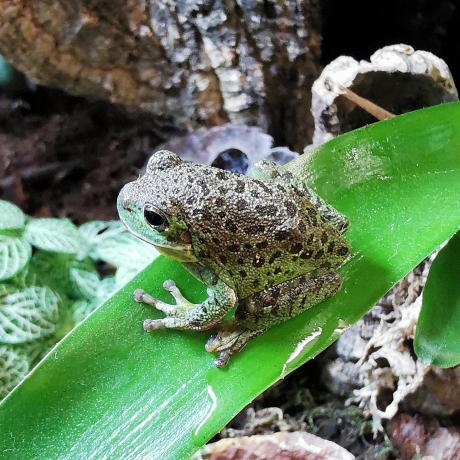

Barking Tree Frogs are found in the south-east of the United States along the coastline. They generally have a green body with small circular brown to yellowish markings.
| Origin | Southern Florida and eastern Louisiana |
|---|---|
| Environment | Rainforests and woodlands |
| Adult Size | 5-7cm |
| Suitability | Beginner |
| Lifespan | 10 years + |
| Food Type | Insectivores |
The Barking Tree Frog is the largest native species in the United States reaching an adult size of 5-7cm (2-2.8inches). These frogs are not like other species, their skin is pretty unique and has a leathery texture. They can also change their colour depending on temperature, light levels, time of day and their surroundings.
They have a typical tree frog appearance with large golden eyes, big toe pads and a plump looking body. Overall colour is green but this can vary in each individual from dull to bright green, yellowish, brown or grey. Small spots are present and varying from green-yellow to grey. Males are recognised by the large vocal sack and have a distinctive call that is disturbingly harsh and loud.
Barking Tree Frogs inhabit woodland areas to open grasslands and bushes. During the day they will rest and save energy in the treetops and become active at night. If they become too hot, they will burrow deep into the soil/sand, they have also been know to do this against predators.
They are native to south-eastern America usually around coastal areas in southern Florida and eastern Louisiana. There are also some isolated colonies in Maryland, Kentucky, and Tennessee.
Keeping Barking Tree Frogs is relatively easy as they are very hardy in captivity. You will require an arboreal glass terrarium, ideally, 45x45x60 would be well suited for a small group and allow ample space for moving around. This needs to be heated to a basking area of 24-26° C (75-79F) which can be achieved with a ceramic reflector clamp lamp, ceramic bulb connected to a thermostat. The ambient daytime temperature should read 22C (72F) and allow the night time temperatures to drop to no lower than 18C (65F). This species is pretty tolerant to slight variations in temperature for a short period of time. We provide all our amphibians UVB as most will require ‘zone 1’ on the Ferguson index scale.
Use a tropical mix designed for forest species which includes soil, forest bark and moss, this mixture will help keep humidity levels a little higher too. Provide plenty of coverage in the form of natural branches and plenty of artificial plants. You could go down the BioActive route and provide a fully live planted enclosure, to succeed with this, you will need to use a LED light designed for plant growth.
As with all amphibians, provide a decent sized water bowl to allow the animals to fully submerge. The water must be treated with a de-chlorinator to remove harmful chemicals, metals and also to add electrolytes. We would recommend misting the enclosure with treated water once a day, twice a day in the warm summer months, otherwise you may find your tree frog burrowing into the substrate.
Food for these little guys is pretty much anything that moves. Always keep to the guidelines of only feeding insects the same size of the width of the eyes, this prevents choking. We like to feed mainly crickets and locusts with calci worm flies and wax worm moths. The food is always dusted with an appropriate calcium/vitamin supplement as directed on the container.
Do not handle the tree frogs and if you must move them, please do this with wet latex gloves on. Wetting your hands before moving will also help, but keep to a minimum as our skin contains chemicals that can damage the frogs fragile skin.